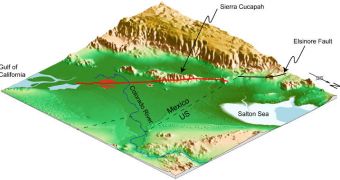A team of geologists and seismologists studying the April 4, 2010, El Mayor-Cucapah earthquake in Baja California, Mexico, discovered that the fault lines the event ruffled up were more crumpled underground than they were on the surface. A tremor usually causes the opposite effect.
When an earthquake occurs, fault lines rupture. As this happens, they form a pattern on the surface, which can be easily noticed by scientists. According to geologists, these patterns resemble the scars left behind on the skin after a heavy wound has healed.
By studying these “scars,” investigator can determined the origins and characteristics of the original earthquakes. Generally, these tracks are more visible on the surface, wheres deep underground the fault lines remain relatively straight.
This is not at all what investigators found in Baja California. On the surface, the fault line that produced the magnitude 7.2 earthquake appears to be straight and smooth, whereas at depth it is very crumpled up and warped.
Geologists say that this is a highly-uncommon occurrence, which will require some thinking on the part of experts in order to fit into our current models of how earthquakes take place. Details of the investigation appear in the latest issue of the esteemed scientific journal Nature Geoscience.
California Institute of Technology (Caltech) investigators led the new study, which was carried out in collaboration with a team of experts at the NASA Jet Propulsion Laboratory (JPL), also in Pasadena. The JPL team was led by geophysicist Eric Fielding.
According to the group, transform plate boundary structures that develop where two plates slide past one another tend to be vertically oriented, whereas the ones they studied proved to be angled.
The fault line rupture itself was about 120 kilometers long, and it involved a non-vertical fault. “Although the surface trace is nearly linear, we found that the event, which started with a smaller quake, happened mainly on two faults with opposite dipping directions,” Shengji Wei says.
The expert – who was also the lead author of the new investigation – holds an appointment as a postdoctoral scholar in geophysics at Caltech. “The new analysis indicates the responsible fault is more segmented deep down than its straight surface trace suggests,” an Institute press release says.
“Anticipating the characteristics of earthquakes that would likely happen on young fault systems (like the event in the study) is a challenge, since the geologic structures involved in the new fault systems are not clear enough,” the document adds.

 14 DAY TRIAL //
14 DAY TRIAL //